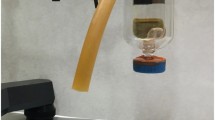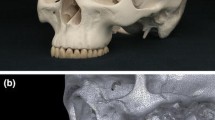Summary
For this study, seven different types of phantom were made simulating the condyle. The phantoms attached to a human dry skull were tomographed using the Polytome-U, under identical conditions to those of tomography for patients.
There was no significant difference of the images between tube side and film side of the mandible. The images of the medial part of the TMJ were clearer than that of the lateral part.
A discrepancy of contours on the focal plane between the phantom and the tomographic image occurred when the inclination of the phantom surface was larger than the maximum exposure angle.
Concerning the influence of focal movements to image quality, the images obtained from hypocycloidal movements were superior with minimum superimposition, although the contrast of the image varied when the phase of the hypocycloidal movements were altered. Any sectional images were not manifested with the phantoms when the inclination of the phantom surface was larger than 23 degrees.
Furthermore, 106 condyles from human dry skull were examined on the area of which the inclination of the condylar surface was less than 23 degrees. The mean latero-medial distance of the area was 14.1mm, which corresponded to 75% of whole latero-medial distance of the condyle.
Similar content being viewed by others
References
Ricketts, R. M.:The temporomandibular joint. 2nd ed. pp. 102–132, 1964, Thomas Books, Springfield
Mongini, F.: The importance of radiography in the diagnosis of TMJ dysfunctions. A comparative evaluation of transcranial radiographs and serial tomography.J. Prosthet. Dent. 45: 186–198, 1981
Petersson, A. and Nanthaviroj, S.: Radiography of the temporomandibular joint utilizing in the transmaxillary projection.Dentomaxillofac. Radiol. 4: 76–83, 1975
Hansson, L. G. and Petersson, A.: Radiography of the temporomandibular joint using the transpharyngeal projection.Dentomaxillofac. Radiol. 7: 69–78, 1978
Weinberg, L. A.: Practical evaluation of the lateral temporomandibular joint radiograph.J. Prosthet. Dent. 51: 676–685, 1984
Ricketts, R. M.: Laminagraphy in the diagnosis of temporomandibular joint disorders.J. Am. Dent. Assoc. 46: 620–648, 1953
Ogura, H.: A diagnostic study on the temporomandibular arthrosis using tomography. — threedimensional measurement of TMJ bony space—.Jap. Soc. Dent. Radiol. 24: 81–99, 1984 (in Japanese)
Ricketts, R. M.: Variations of the temporomandibular joint as revealed by cephalometric laminagraphy.Am. J. Orthod. 36: 877–898, 1950
Blair, G. S. et al.: Circular tomography of the temporomandibular joint. A critical evaluation of the accuracy and reproducibility of the technique.Oral Surg. Oral Med. Oral Pathol. 35: 416–427, 1973
Pullinger, A. G. and Hollender, L.: Variation in condyle-fossa relationship according to different methods of evaluation in tomograms.Oral Surg. Oral Med. Oral Pathol. 67: 719–727, 1986
Marstrander, F.: Fundamental problems in connection with image formation in tomography.Acta Radiol. [Suppl. 116]: 208–216, 1954
Mattson, O.: Control of a tomographic system.Acta Radiol. [Diag.] 8: 433–445, 1969
Reichmann, S.: Development of spurious contours of spherical and cylindrical objects in tomography.Acta Radiol. [Diag.] 12: 317–334, 1972
Eckerdal, O.: Tomography of the temporomandibular joint.Medicamundi 16: 144–150, 1971
Eckerdal, O.: Tomography of the temporomandibular joint.Acta Radiol. [Suppl 324] 1973
Yale, S. H., Allison, B. D. and Hauptfuehrer, J. D.: An epidemiological assessment of mandibular condyle morphology.Oral Surg. Oral Med. Oral Pathol. 21: 169–177, 1966
ICRU report 10f:Methods of evaluating radiological equipment and materials. pp. 15–26, 1963, Washington D. C., U.S.A.
Miller, T. L., Katzberg, R. W. et al.: Temporomandibular joint clicking with nonreducing anterior displacement of the meniscus.Radiology 154: 121–124, 1985
Dantoko, Y.:Text book of clinico-radiological technology 6th ed. pp. 69–77, 1984, Nankodo, Tokyo (in Japanese)
Littleton, J. T.: Some blurring characteristics of small angle tomography.Medicamundi 10: 10–20, 1964
Korach, G. et al.: Selective employment of the Polytome in accordance with type of examination.Medicamundi 11: 82–91, 1966
Author information
Authors and Affiliations
Rights and permissions
About this article
Cite this article
Takahashi, A., Fuchihata, H. A study on reliability of the tomographic image of the temporomandibular joint. Oral Radiol. 5, 11–22 (1989). https://doi.org/10.1007/BF02350098
Received:
Accepted:
Issue Date:
DOI: https://doi.org/10.1007/BF02350098




